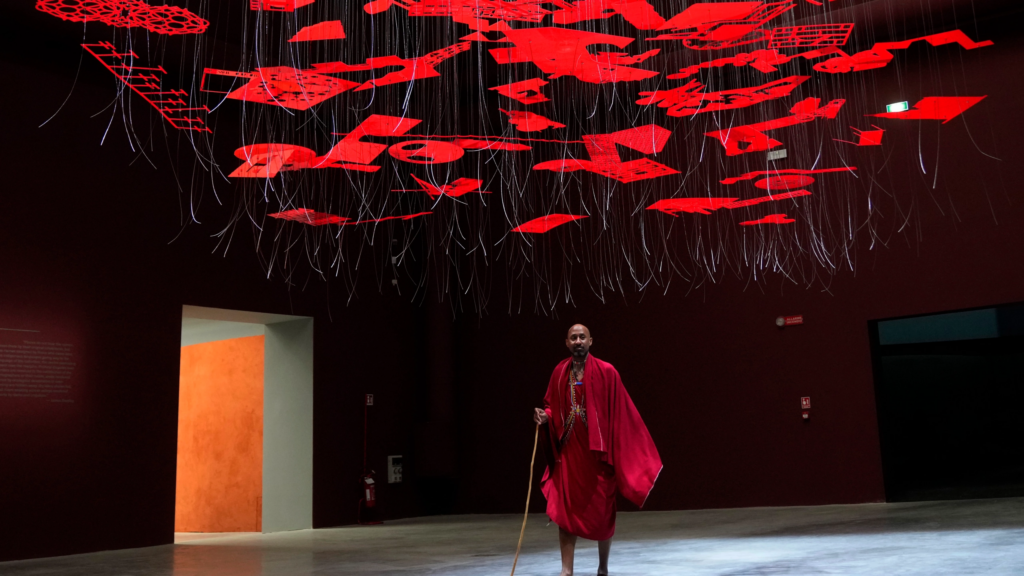
Africa finally speaks in Venice Architectural Biennale 2023
This year’s Venice Architecture Biennale, coordinated by Scottish-Ghanaian architect Lesley Lokko, has a majority of African and African diaspora art.
Lokko said Africans have much to say about decolonization and decarbonization, which the 18th architectural Biennale, “The Laboratory of the Future,” tackles.
Europe’s first energy unit was the Black body. Lokko told AP last week. We’ve always used resources. Our resources are unstable. Fragile, too. Exploited regularly. We exploit them.”
Lokko included David Adjaye and Theaster Gates among 89 primary exhibition performers, more than half of them were African or African diaspora. Lokko pushed architects, artists, and designers to be “paper-thin” with their exhibitions to lessen the Biennale’s carbon impact, resulting in more drawings, video, and projections and the reuse of materials from last year’s contemporary art Biennale.
Lokko remarked, “This exhibition shows that this work, this imagination, this creativity, has been around for a very, very long time.” “It just hasn’t found the right space, in the same way.”

Why has an African-focused show taken so long to reach Venice, a prominent international platform?
In 2015, the late Nigerian art critic and museum director Okwui Enwezor became the first African to lead the Venice Biennale contemporary art fair, which alternates years with the architectural exposition. President Roberto Cicutto named Lokko as the inaugural Biennale curator in 2020, following the US death of George Floyd.
“This is more for us than them,” Cicutto added, “to see the production, hear the voices we have heard too little, or heard in the way we wanted.”
The Italian embassy in Ghana denied visas for three of Lokko’s partners, which Lokko called “an old and familiar tale” this week.
The main pavilion’s corrugated metal roof carved into reconstructed Venetian winged lions suggests a North-South emphasis. Africa and other underdeveloped countries use the material for free shade. Cultural appropriation is symbolized by the African lion, Venice’s emblem for centuries.
“No lions here,” Lokko joked.
Adjaye’s workshop displays architectural models “outside the dominant canon,” such South Africa’s Thabo Mbeki Presidential Library, which was inspired by pre-colonial architecture. “Parliament of Ghosts” by Ghanaian artist Ibrahim Mahama examines colonial abuse.
Olalekan Jeyifous, a Brooklyn-based Nigerian, writes a vast retro-futuristic tale about the imaginary development of a unified African Conservation Effort a decade after African liberation in an alternate 1972.
No utopia. His global Africa flattens local customs.
Never utopia/dystopia. He stated he wanted to operate outside of Western binary concepts. It’s not just: We’ve fixed everything. Everything’s great. Never that easy.”
The 64 national participants’ pavilions echoed Lokko’s themes of climate change and inclusive discussion more than in prior editions.
Denmark proposed Copenhagen islands that allow the sea to construct canals like Venice’s to combat rising seas. Venice’s underwater barricades, which had to be lifted during the Biennale preview week in May for the first time, contrast with the approach.
Decolonization was a natural subject for the Brazilian pavilion, where curators Gabriela de Matos and Paulo Tavares showed indigenous and African Brazilian architecture and challenged the “hegemonic” idea that Brasilia was erected in the “middle of nowhere.”
Tavares said decolonization is a discipline. “Freedom and democracy are open words.”
Under the theme “Everlasting Plastic,” the U.S. Pavilion examined how to handle plastic, created and spread in the US. In one of the five displays, Chicago-based African American artist, designer, and furniture-maker Norman Teague utilized recycled plastics from Tide laundry detergent bottles to construct one-of-a-kind baskets inspired by Senegalese and Ghanaian weaves.
Lokko’s themes encouraged Teague to “really think about the lineage between the continent and Chicago.”
Ukraine returns to the Biennale with two installations that subtly remind us of Europe’s ongoing war. The Arsenale pavilion’s black-out materials depict Ukrainians’ ad hoc, though ineffective, protection against Russian shelling.
Iryna Miroshnykova, Oleksii Petrov, and Borys Filonenko rebuilt 10th-century clay mounds at the Giardini. They defeated Russian tanks last spring despite being abandoned by modern farming and development.
Despite their somber message, the curators encourage visitors will recline and youngsters may roll down the grassy slopes.
“These fortifications are peaceful and relaxing. But it’s also a reminder that someone is in danger, Filonenko added.
